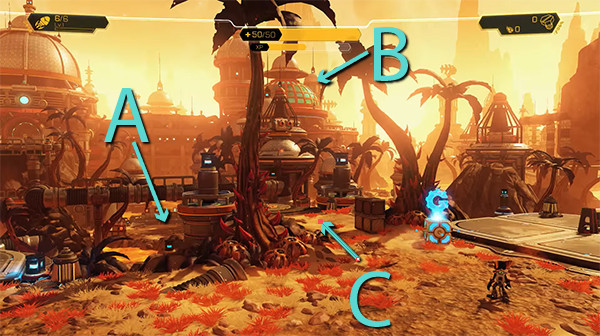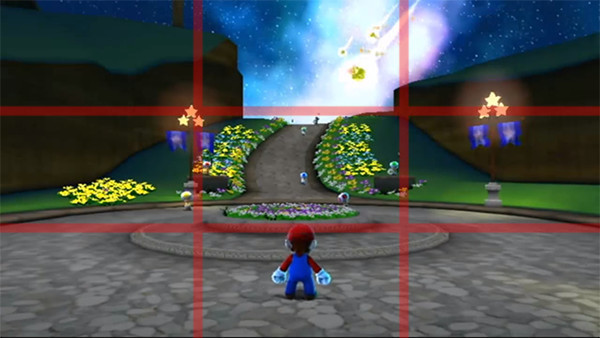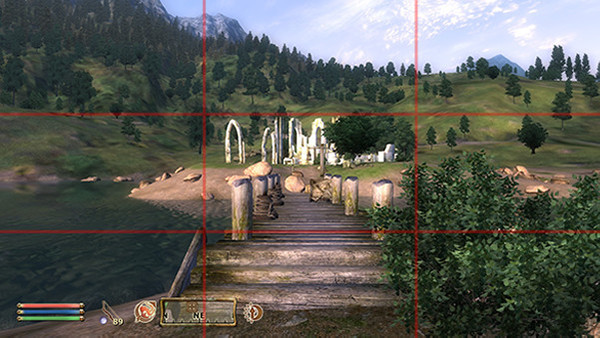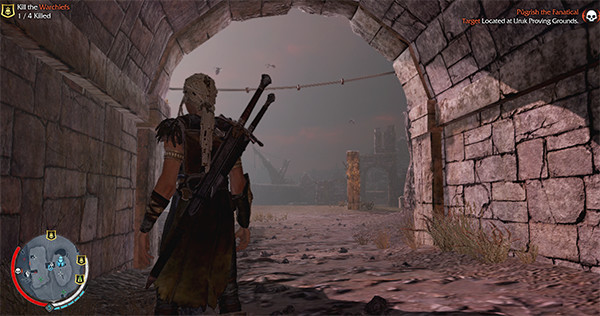View and perspective in level design. Part two
There are many methods that help designers attract the attention of users. In some games, video clips (or camera spans) are used to direct the players 'attention to important, according to the developers' idea, elements. But by doing so, players are deprived of control. In other games, on the contrary, players can access important elements with their own hands by pressing a special button.
Anyway, in this article we will talk about a great way to direct attention - creating an initially literate level composition due to the clever use of appearance and perspective.

')
The first part of the translation of the article here .
A good example would be the PlayStation 2 series of Ratchet & Clank games, on which I worked as a designer.
The video below shows the opening view of the Metropolis from the first game of the Ratchet & Clank series. The player leaves his ship through a long tunnel, forming a perspective, through which the view is partially visible. Having reached the open area shown in the video, it is completely immersed in the unique atmosphere of the city.
When we worked on the level design for these games, building a beautiful initial look was one of the main tasks. Over time, we developed 3 main criteria for creating the right opening view:
1. Add motion to attract attention
Several levels of air traffic create traffic in the frame. We found that the dynamic picture attracts more attention than a static screen.
Note: in games with a slower pace or a heavy atmosphere, you need to slow down. But we wanted to make Ratchet & Clank games quick and easy.
2. Show the player a goal
The building in the center is the station, the player’s ultimate goal at this level. After reaching there, the player will take a train journey around the city. And it will end exactly in the place where it began.
3. Shine game art and technology
This game was first released for the PS2 (the HD version is shown in the video), so one of its technical strengths was how far open space was viewed in it, compared to other games of the time on the PS2. Our artists used the latest technology to create truly beautiful views like the one shown on the video.
Accents
We used a number of tricks to position the camera as efficiently as possible. Of course, first of all it was necessary to choose the items to which we wanted to draw attention. In the role of emphasis can be any significant, in your opinion, details, and you need to choose them according to your goals:
Regardless of your goals, you need to find such details of the composition that the player should notice, and then build the level in such a way as to achieve these goals.

The image above can be divided into 3 main points:
As soon as you decide on accents, you will need to somehow draw attention to them. There are many ways to do this. Here are some of them:
Attract attention
Learn to draw the attention of players to the accents of your composition and give them maximum expressiveness.
Perspective and movement
In the game Half-Life 2, one can observe how a combination of perspective and movement is used to explain to the player the peculiarities of the behavior of a barnacle.
Lines
We have already mentioned this, but repeat it. Notice how the landscape lines turn your gaze toward the ruins:

It turns out naturally, without a huge neon sign that says: “Hey, look what a ruin!”.
Camera location
Another effective way to attract the attention of players is to position the camera so that the important parts of the composition fall along the lines dividing it into thirds, or at their intersection. This is a very old principle, dating back to the Renaissance.
We will not consider it in detail here, but if you are interested in the rule of thirds, read this lesson on photography.
I will try to explain this principle on the example of a familiar image from Super Mario Galaxy:

Lines break the screen into thirds. Please note: all important parts of the composition are either completely placed in one of these thirds, or are crossed by one or several lines. This principle also helps to manage the attention of users.
Depending on your goals, you can achieve many things with this simple, at first glance, reception.
Let's say you want to focus the player’s attention on a single goal or in one direction. You can place the desired part in the central unit, like this:

In the screenshot above, the ruins are not just located in the center - the perspective formed by the berth line additionally focuses attention on them.
But, most likely, the creators of the game Oblivion just wanted to push the players to explore the ruins, without giving the impression that this is necessary. Centering, as in my screenshot, creates an impression of the ruins as the most important object, and also makes all other objects less noticeable. In short, this is too intrusive.

And this is a real screenshot from the game (I already used it when talking about lines). The focus is still focused on the ruins, but the view around them has become more expressive. Looking in this perspective, the player understands: it is not important where he goes, but what a big and interesting world around him.
The pier is located at the intersection of the lower and right lines, and stretches from the lower right third to the middle block. As I said earlier, this situation helps to direct your gaze towards the ruins.
But what if you want players to notice not one, but several items?

In this image, the ruins are located almost at the intersection of the left and top lines, which again distinguishes them from the composition. The quay is centrally located, but it also looks away to the ruins, as it points to them.
But, unlike other images, this shows the beginning of the path leading to the right, off the screen; on it also point the lines of the pier. It is this path that will lead the player towards the main storyline of the game and fresh quests. Therefore, if I wanted to divide the player’s attention and put it before a choice, I would do just that.
View in non-linear games
Speaking about the game Oblivion, I want to briefly outline how these principles are applied in non-linear games. We discussed how the view and perspective are used in it, when the designer can partially control the camera (for example, after loading). But they are also often used in those situations where the player completely controls the situation - by directing the player to the desired form.

Screenshot from Middle-earth: Shadows of Mordor shows how it works. The game world is completely open to exploration, but the game often guides the player through a system of narrow spaces that perform the function of a peculiar perspective. The view of the exit from each tunnel is thought out in the smallest detail to show the player new places that he can explore.
Conclusion
Perspective, view, initial view - all these tools are very important for building levels. Using the techniques discussed here, you can intelligently apply these tools and supplement them with other methods in your level design.
Anyway, in this article we will talk about a great way to direct attention - creating an initially literate level composition due to the clever use of appearance and perspective.

')
The first part of the translation of the article here .
A good example would be the PlayStation 2 series of Ratchet & Clank games, on which I worked as a designer.
The video below shows the opening view of the Metropolis from the first game of the Ratchet & Clank series. The player leaves his ship through a long tunnel, forming a perspective, through which the view is partially visible. Having reached the open area shown in the video, it is completely immersed in the unique atmosphere of the city.
When we worked on the level design for these games, building a beautiful initial look was one of the main tasks. Over time, we developed 3 main criteria for creating the right opening view:
1. Add motion to attract attention
Several levels of air traffic create traffic in the frame. We found that the dynamic picture attracts more attention than a static screen.
Note: in games with a slower pace or a heavy atmosphere, you need to slow down. But we wanted to make Ratchet & Clank games quick and easy.
2. Show the player a goal
The building in the center is the station, the player’s ultimate goal at this level. After reaching there, the player will take a train journey around the city. And it will end exactly in the place where it began.
3. Shine game art and technology
This game was first released for the PS2 (the HD version is shown in the video), so one of its technical strengths was how far open space was viewed in it, compared to other games of the time on the PS2. Our artists used the latest technology to create truly beautiful views like the one shown on the video.
Accents
We used a number of tricks to position the camera as efficiently as possible. Of course, first of all it was necessary to choose the items to which we wanted to draw attention. In the role of emphasis can be any significant, in your opinion, details, and you need to choose them according to your goals:
- Do you want to pay attention to the cool game art?
- Do you want to give a hint or indicate the direction?
- Do you want to tell a story or work a story?
Regardless of your goals, you need to find such details of the composition that the player should notice, and then build the level in such a way as to achieve these goals.

The image above can be divided into 3 main points:
- A is the goal. The player will soon have to go there.
- In - game art. The huge tower is the main feature of this level.
- C - the road ahead. A small “springboard” leads the player forward (since the lines point toward point A).
As soon as you decide on accents, you will need to somehow draw attention to them. There are many ways to do this. Here are some of them:
Attract attention
Learn to draw the attention of players to the accents of your composition and give them maximum expressiveness.
Perspective and movement
In the game Half-Life 2, one can observe how a combination of perspective and movement is used to explain to the player the peculiarities of the behavior of a barnacle.
- The player approaches the aisle between the train and the wall.
- The slope of the surface provides the angle of the camera at which the player pays attention to the bird, and the passage between the wall and the train determines the direction of his gaze.
- The movement of the bird attracts the attention of the player and makes him turn his head after her.
- As soon as the barnacle eats the bird, the player becomes aware of the principle of his attack (the barnacle will try to eat you if you touch his hanging out tongue, as was the case with the bird).
Lines
We have already mentioned this, but repeat it. Notice how the landscape lines turn your gaze toward the ruins:

It turns out naturally, without a huge neon sign that says: “Hey, look what a ruin!”.
Camera location
Another effective way to attract the attention of players is to position the camera so that the important parts of the composition fall along the lines dividing it into thirds, or at their intersection. This is a very old principle, dating back to the Renaissance.
We will not consider it in detail here, but if you are interested in the rule of thirds, read this lesson on photography.
I will try to explain this principle on the example of a familiar image from Super Mario Galaxy:

Lines break the screen into thirds. Please note: all important parts of the composition are either completely placed in one of these thirds, or are crossed by one or several lines. This principle also helps to manage the attention of users.
Depending on your goals, you can achieve many things with this simple, at first glance, reception.
Let's say you want to focus the player’s attention on a single goal or in one direction. You can place the desired part in the central unit, like this:

In the screenshot above, the ruins are not just located in the center - the perspective formed by the berth line additionally focuses attention on them.
But, most likely, the creators of the game Oblivion just wanted to push the players to explore the ruins, without giving the impression that this is necessary. Centering, as in my screenshot, creates an impression of the ruins as the most important object, and also makes all other objects less noticeable. In short, this is too intrusive.

And this is a real screenshot from the game (I already used it when talking about lines). The focus is still focused on the ruins, but the view around them has become more expressive. Looking in this perspective, the player understands: it is not important where he goes, but what a big and interesting world around him.
The pier is located at the intersection of the lower and right lines, and stretches from the lower right third to the middle block. As I said earlier, this situation helps to direct your gaze towards the ruins.
But what if you want players to notice not one, but several items?

In this image, the ruins are located almost at the intersection of the left and top lines, which again distinguishes them from the composition. The quay is centrally located, but it also looks away to the ruins, as it points to them.
But, unlike other images, this shows the beginning of the path leading to the right, off the screen; on it also point the lines of the pier. It is this path that will lead the player towards the main storyline of the game and fresh quests. Therefore, if I wanted to divide the player’s attention and put it before a choice, I would do just that.
View in non-linear games
Speaking about the game Oblivion, I want to briefly outline how these principles are applied in non-linear games. We discussed how the view and perspective are used in it, when the designer can partially control the camera (for example, after loading). But they are also often used in those situations where the player completely controls the situation - by directing the player to the desired form.

Screenshot from Middle-earth: Shadows of Mordor shows how it works. The game world is completely open to exploration, but the game often guides the player through a system of narrow spaces that perform the function of a peculiar perspective. The view of the exit from each tunnel is thought out in the smallest detail to show the player new places that he can explore.
Conclusion
Perspective, view, initial view - all these tools are very important for building levels. Using the techniques discussed here, you can intelligently apply these tools and supplement them with other methods in your level design.
Source: https://habr.com/ru/post/306364/
All Articles